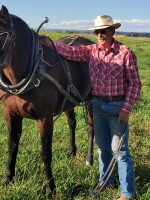This is Bob Bragg with the Farm News & Views report for the week of February 24th.
As I’ve gathered information for the Farm News and Views Report over the past couple of weeks, it’s apparent to me that those who are setting agricultural policy and determining the validity of contracts made with agricultural producers are mostly ignorant of how farmers and ranchers produce food and fiber for this Nation. The ad hoc DOGE team has wreaked havoc on agricultural producers who have availed themselves of funding to improve their communities, farmland and the environment. Also, several thousand loyal employees at USDA research centers and USDA Farm Service Agency offices, many of whom have provided services in small rural communities for years, have been sacked for no reason. Many of them now carry the unfair stigma of being fired which may prevent them from drawing unemployment compensation and finding work at another federal agency. The impact of these actions is devastating for many small rural communities that depend on reliable, good paying jobs.
For some reason, last week, newly installed Secretary of Agriculture Brooke Rollins said that farmers are facing their "worst economic straits in nearly a century. But on February 6th, the USDA Economic Research Service reported that net farm income is forecast to increase in 2025 after declining in 2023 and 2024 from a record high in 2022. The agency estimated net farm income of $180.1 billion for 2025, $41.0 billion higher than in 2024, and net cash farm income is forecast at $193.7 billion for 2025, an increase of $34.5 billion relative to 2024. So was Rollins deflecting attention from cutting USDA staff across agencies and announcing that they were not honoring contracts made with farmers and rural organizations, however, last Friday, the agency agreed to honor the contracts that were already made with farmers. Specifically, USDA is releasing approximately $20 million for the Environmental Quality Incentive Program, Conservation Stewardship Program, and the Agricultural Conservation Easement Program. But the agency didn’t include releasing $1.5 billion in funding for 92 Regional Conservation Partnership Program Projects that were approved last year. These projects include multiple partners and agencies and that were aimed at scaling up conservation practices in areas such as large watersheds. Last week, the U.S. District Court for District of Columbia ordered federal agencies to release all frozen funds tied to the Federal Inflation Reduction Act. But, the Trump administration hasn’t provided details about how or when it will release the more than $30 billion in economic and disaster aid passed by Congress in December.
Reuters News Service reported that Turkey is beginning to ship about 16 and a half tons of eggs to the U.S. over the next six months in response to the bird flu virus that has dramatically decreased the supply of eggs in this country, sending prices soaring. The USDA is forecasting an additional 20% increase in egg prices this year, because it will take months to replace lost flocks. While the Trump administration is gearing up to vaccinate poultry on a large scale, probably so that he can claim that his efforts brought down the price of eggs, the National Chicken Council is warning that “vaccination in any poultry sector, whether egg layers, turkeys, broilers, or ducks will jeopardize the entire $5.53 billion U.S. poultry meat export market, ” because “most U.S. trading partners don’t recognize countries that vaccinate as ‘free of HPAI’ due to concerns that vaccines can mask the presence of the virus.”
The Trump administration says it plans to roll out a new strategy against the bird flu. There are few details, but officials say the plan is aimed at trying to minimize the slaughter of chickens when the disease strikes a flock. And that's in order to bring rising egg prices down.There are also other hurdles for a vaccination program. First, the federal government and manufacturers will still need to make enough vaccines to immunize poultry farms across the U.S. If the federal government were to vaccinate poultry, it could come with a number of complications, notably that many U.S. trading partners won’t accept exports from countries that allow vaccinations, according to Carol Cardona, an expert on avian health at the University of Minnesota. Cardona, also points out that “When we talk about poultry, we’re talking about ducks and turkeys and chickens, and that’s the chickens we eat and the egg laying chickens, and they’re all grouped together in terms of trade restrictions,” She points out that the broiler industry that is responsible for raising chicken specifically for meat consumption would likely be the most impacted. That sector of poultry production represents about 96% of the poultry industry, supplying a large export market that provides $449.5 billion in economic activity and $36.7 billion in government revenue, according to the U.S. Poultry and Egg Association. Cardona contends that “The broiler industry, in their own interest, would say, ‘No, no vaccine until there are no egg layers left.”
Daniel Perez, a poultry medicine expert at the University of Georgia College of Veterinary Medicine who studies how influenza viruses jump from animals to humans, said he’s concerned that vaccinating poultry could facilitate silent spread, where transmission occurs in asymptomatic birds. “Vaccines can sometimes be seen as kind of a double-edged sword,” Perez said. “They can control the disease, but at the same time, they may not be able to control infections. So vaccinated animals may show no signs of the disease. As is seen with vaccinated humans, not every vaccinated bird will be protected or have the same level of protection as the next,”
So we must hope that the Trump Administration takes the long view, rather than rushing into a quick fix that leads to a more serious epidemic.
Benjamin Franklin wrote, “He that is good for making excuses is seldom good for anything else.”



